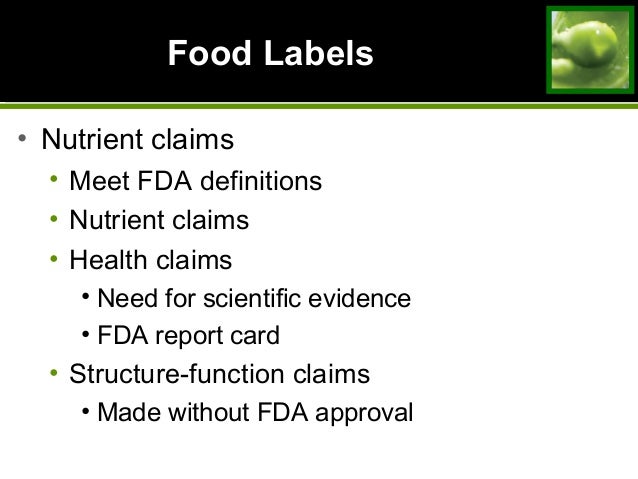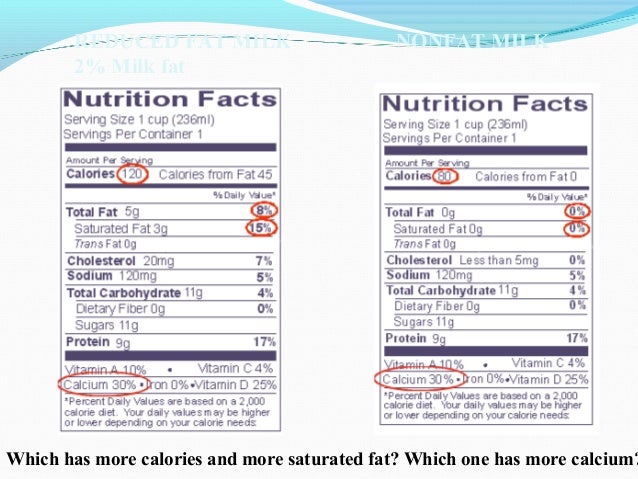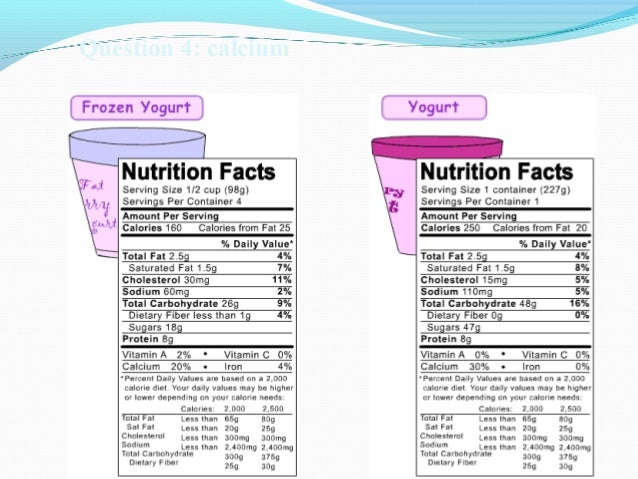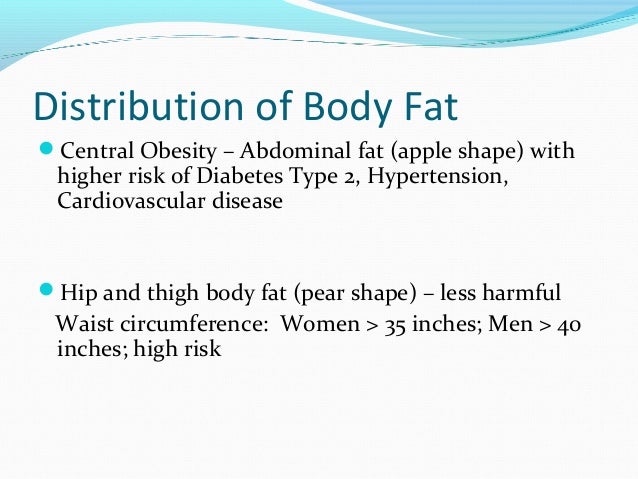42 analyze food labels for energy content
Understanding food labels: portions, energy | Health24 When next you look at a food label that says 'low in energy', first check the label to see how much energy it really contains. That energy bar we were discussing earlier may contain as much as 500kJ per 50g portion (which means it contains 1000kJ per 100g). Therefore, it is anything but 'low in energy'. Energy content of slimming products The Importance of Reading the Food Label and Nutritional Facts All labels provide key information about any given packaged food, such as serving size, number of calories, fat content, cholesterol, protein, sugar content, carbohydrates, etc. And of course, each label also provides a list of ingredients so you know exactly how any given food product is made.
PDF Energy Content of Foods Your Name Lab Partners: Period ... The data showed that high fat foods have more energy than high sugar foods which was expected. The food with the highest energy content per gram was the peanut at 6186.4 J/g. The food with the lowest energy content per gram was the marshmallow at 362.3 J/g. This

Analyze food labels for energy content
Food labels: a guide to reading nutrition labels - MyDr.com.au Solid foods labelled as 'low-fat' must not contain more than 3 grams of fat per 100 gram; 'low-fat' liquid foods must not contain more than 1.5 grams of fat per 100 mL. Only foods that are low fat can use a fat-free claim. Labels can therefore only claim that a food is 97%, 98% or 99% fat free. 'Low cholesterol' Investigating the Energy Content of Foods - Vernier You can determine energy content of food by burning a portion of it and capturing the heat released to a known amount of water. This technique is called calorimetry. The energy content of the food is the amount of heat produced by the combustion of 1 gram of the food, and is measured in kilojoules per gram (kJ/g). Objectives Nutrition labelling | Food Standards Agency When providing nutrition information, you are required to declare: energy value. amounts of fat, saturates, carbohydrate, sugars, protein and salt. The content of the mandatory nutrition declaration can be supplemented with an indication of the amounts of one or more of the following: monounsaturates. polyunsaturates.
Analyze food labels for energy content. The Basics of the Nutrition Facts Label A food item with a 5% DV of fat provides 5% of the total fat that a person who needs 2,000 calories a day should eat. You may need more or less than 2,000 calories per day. This means that you may need more or less than 100% DV that is listed on the package for some nutrients. Low is 5% or less. Energy Content of Food Lab Report Answers - SchoolWorkHelper Takedown all the readings. Repeat steps 1 to 12 for 3 times for each different type of chip. Find the average initial temperature, final temperature, and mass of the food sample. Use the formula, Energy = Volume of water x (initial-final temperature) x 4.2/ mass of food sample. For each different type of chips Labelling-Determination of the energy content of food Currently used polyols include sorbitol and erythritol. Carbohydrates give average gross energy values of 4.2 kcal or 17.6 kJ per gram, fat gives 9.4 kcal, or 39.4 kJ per gram and protein gives 5.65 kcal or 23.7 kJ per gram. The conversion factors for joules and calories are: 1 kJ = 0.239 kcal; and 1 kcal = 4.184 kJ. Chapter 3: Calculation of The Energy Content of Foods ... determining the energy content of foods depends on the following: 1) the components of food that provide energy (protein, fat, carbohydrate, alcohol, polyols, organic acids and novel compounds) should be determined by appropriate analytical methods; 2) the quantity of each individual component must be converted to food energy using a generally …
Food Labeling & Nutrition | FDA Food labeling is required for most prepared foods, such as breads, cereals, canned and frozen foods, snacks, desserts, drinks, etc. Nutrition labeling for raw produce (fruits and vegetables) and ... How to calculate the Energy available from foods To calculate the energy available from a food, multiply the number of grams of carbohydrate, protein, and fat by 4,4, and 9, respectively. Then add the results together. For example, 1 slice of bread with a tablespoon of peanut butter on it contains 16 grams carbohydrate, 7 grams protein, and 9 grams fat : 16g carbohydrate x 4 kcal/g = 64 kca l PDF Calorimetry: Measuring the Energy in Foods 5. Calculate the energy content of the food in kilocalories/gram. 1.65 kcal/1.5 g = 1.1 kcal/g 6. Using information on the nutrition label of the food sample, calculate the food manufacturer's kilocalories/gram. (Divide calories per serving by the number of grams in a serving.) 90 Cal/ 38 g = 2.37 kilocal/gram 7. Food Label Analysis Worksheet for 5th - 9th Grade | Lesson ... Rate this Resource Food Label Analysis Encourage healthy eating and demonstrate how to read a food label with this worksheet. Class members choose a food and respond to fill in the blank questions regarding calories, daily values, and ingredients.
Analyze_Data_Explore_Per 2.docx - NAME DATE CLASS ... The label provides useful information for identifying the energy content of food, the source of that energy, and other nutritional information. The figure shows two sample food labels. Notice that the largest font on the labels is used to show Calories, with a capital C. The Science Behind Calories and Nutrition Facts Labels ... The calorie number we see on food labels refers to a kilocalorie (kcal), which is also known as a large calorie or a food calorie. A kilocalorie is 1 000 calories. One kilocalorie is the amount of energy it takes to heat one kilogram of water one degree Celsius at sea level. Food Labels - Nutrition.gov Food and Drug Administration (FDA) regulates the safety of food for humans and animals, including foods produced from genetically engineered (GE) plants, sometimes referred to as "genetically modified organisms" (GMOs). Find out more about the safety of GE plants, and how they are regulated here. Feed Your Mind: Agricultural Biotechnology/GMOs Energy labelling of alcoholic beverages In December 2021, FSANZ completed a preliminary analysis of regulatory and non-regulatory options for energy labelling of packaged alcoholic beverages to identify a preferred approach. This included targeted consultation with industry, public health, consumer and jurisdictional stakeholders. The key outcomes were:
Practical 1.3 - Investigate the energy content of food ... A simple investigation can be conducted to investigate the energy content of a food sample. Procedure. Add water - around 20cm 3 - to a boiling tube clamped in a retort stand.
Food labels & nutritional information | Raising Children ... Fats, protein and carbohydrates all provide your body with the energy or kilojoules you need to function and do your daily activities. When comparing similar foods, lower energy usually means lower fat or sugar, which means that the food is a better choice for most people. Fat, sugar and salt
Energy in Food and Nutrition | Chemistry for Non-Majors Use the information in this nutrition facts label to determine the amount of Calories (Cal = kcal) and kilojoules (kJ) from fat, carbohydrates and protein in the snack mix. Step 1: List the known quantities and plan the problem . Known Energy per gram Fat = 9 kcal/g (Cal/g) Carbohydrate = 4 kcal/g (Cal/g) Protein = 4 kcal/g (Cal/g) Grams Fat = 11 g
PDF Better Nutrition by Analyzing Food Labels Overview: Students will learn how to interpret food labels and analyze the nutritional composition of foods. They will do so mainly through applying an understanding of percent. To a lesser degree they will write some basic formulas and will also construct a triple bar graph. _____ Student Activities: Better Nutrition by Analyzing Food Labels
How to understand food labels - Eat For Health The Nutrition Information Panel on a food label offers the simplest and easiest way to choose foods with less saturated fat, salt (sodium), added sugars and kilojoules, and more fibre. It can also be used to decide how large one serve of a food group choice or discretionary food would be and whether it's worth the kilojoules.
How is the caloric value of food determined? | Office for ... A food calorie is actually a "kilocalorie.". In other words it is the amount of energy needed to raise the temperature of one liter of water by one degree. Originally, the calorie content of a food was measured in a calorimeter. A known amount of food, which has had its water content evaporated, was placed in a container surrounded by a ...
Reading Food Labels (for Parents) - Nemours KidsHealth A food with 5% or less of a nutrient is low in that nutrient. A food with 10%-19% of a nutrient is a good source of that nutrient. A food with 20% or more of a nutrient is high in that nutrient. The information on food labels is based on an average diet of 2,000 calories per day.
How to Understand and Use the Nutrition Facts Label | FDA Dietary fiber, vitamin D, calcium, iron ad potassium are nutrients on the label that Americans generally do not get the recommended amount of. They are identified as nutrients to get more of....
BSC1005_Food Label Analysis.docx - Food Label Analysis ... Food Label Analysis Assignment 20 points Instructions: In this assignment, you will be analyzing a food for its nutrition content and relating it to energy production in our cells. Please choose a food with a label (not a drink). Using the both the nutrition label and the ingredient label, answer the following questions. Remember, to use the information in your study activities to understand ...
How to Determine the Nutritional Value of Food - FoodCrumbles But in most foods the carbohydrates, proteins, fats and fibre take up most of the energy content. It has been defined by analysis how much energy one gram of these different groups of molecules will give to your body (the regulation mentioned above also contains this information). Calculating energy content is then done as follows: Determine ...
Nutrition labelling | Food Standards Agency When providing nutrition information, you are required to declare: energy value. amounts of fat, saturates, carbohydrate, sugars, protein and salt. The content of the mandatory nutrition declaration can be supplemented with an indication of the amounts of one or more of the following: monounsaturates. polyunsaturates.
Investigating the Energy Content of Foods - Vernier You can determine energy content of food by burning a portion of it and capturing the heat released to a known amount of water. This technique is called calorimetry. The energy content of the food is the amount of heat produced by the combustion of 1 gram of the food, and is measured in kilojoules per gram (kJ/g). Objectives
Food labels: a guide to reading nutrition labels - MyDr.com.au Solid foods labelled as 'low-fat' must not contain more than 3 grams of fat per 100 gram; 'low-fat' liquid foods must not contain more than 1.5 grams of fat per 100 mL. Only foods that are low fat can use a fat-free claim. Labels can therefore only claim that a food is 97%, 98% or 99% fat free. 'Low cholesterol'
















Post a Comment for "42 analyze food labels for energy content"